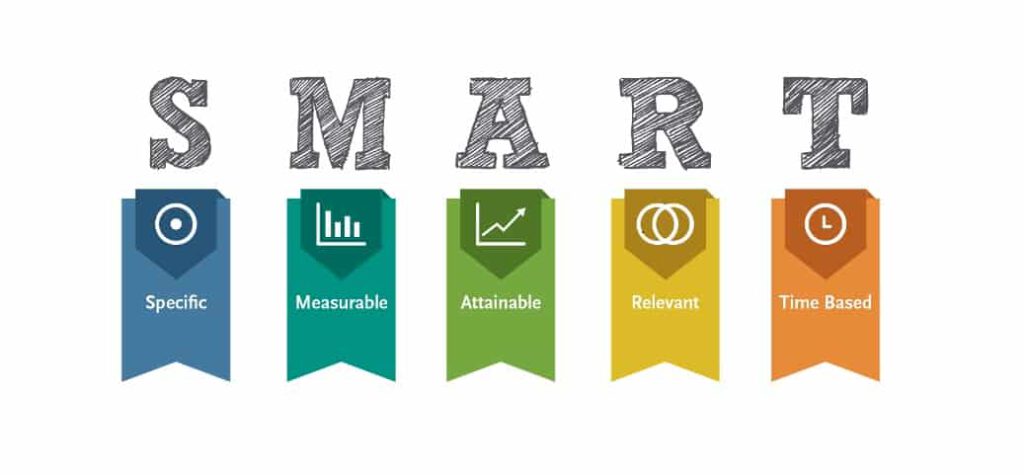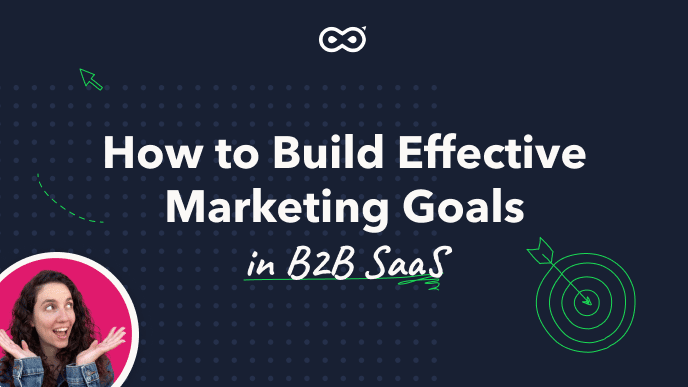Think about three successful B2B SaaS companies.
What makes them stand out?
- Is it their branding?
- Do you like their content?
- Maybe they excel in the paid acquisition and have great ads.
- Is it something else entirely?
Do they even have something in common?
Initially, you might not see much in common between these companies, especially those in different verticals and targeting different audiences. However, all successful B2B SaaS marketing organizations have one thing in common:
Creating marketing goals that correlate with the company’s success – setting and managing effective marketing goals.
To win over their competitors, SaaS marketing teams have to deliver measurable results fast. We all like to think we’re results-oriented, but what do effective marketing goals really mean?
In this article, I’m going to walk you through the process of setting effective marketing goals that will align your team and drive results.
But before we get started, let’s talk about what makes a goal a good one.
Good Goals
If you search for “what makes a good marketing goal”, you’ll probably come across S.M.A.R.T. If you’re anything like me, finish rolling your eyes and keep reading, I promise this will make sense.
Think about it for a second. SMART goals are actually pretty… smart.
Goals that are Specific, Measurable, Attainable, Relevant, and Time-Based are ones you can achieve.
Think about it –
- If it’s too broad, how do you know if the specific actions you do actually make an impact?
- If you can’t measure your goal, how will you know if you accomplished it?
- If you can’t make it happen, aren’t you setting yourself up for failure?
- Is there any point in setting a goal if it isn’t relevant to your company’s growth?
- When do you measure success if you don’t have an end date?

And for InfiniGrow’s secret sauce for great goals: There must be a clear motivation behind them. You see, goals help us with performance evaluation and organizational alignment. By communicating these goals every day, everyone on the team knows their responsibilities, how they support the company growth, and what they have to do to reach those goals.
Let’s get back to setting effective marketing goals.
Establishing Business Goals
You start with establishing a business goal.
Business goals are what a company wants to achieve for a specific period of time. Goals are usually set quarterly and annually basis.
Business goals are usually financial goals such as total revenue, new bookings, annual recurring revenue (ARR) and monthly recurring revenue (MRR), and each team (Marketing, Sales, Customer Success, etc.) contributes to the business goal.
Once the high-level business goal is established, it’s up to the heads of those departments to create their independent goals.
Although the marketing department isn’t directly responsible for creating the company’s business goals, having a well-defined and well-communicated business goal is the basis of the marketing goals.
An example of a business goal would be:
- Hit $15M in ARR by the end of 2024
Creating Your Marketing Goals
After the business goal is established, you can start creating the marketing goals and sporting goals.
The marketing goals are what your marketing organization needs to achieve in order to achieve the company’s business end goal.
When creating marketing goals, you need to account for your own Sales and Marketing metrics such as conversion rates, velocity between funnel stages, average sales cycles, etc. In this way, you can reverse engineer the business goal and determine your marketing objectives.
A marketing contribution to a business goal involves analyzing current and historical marketing performance while taking a variety of external factors into account, like seasons, holidays, and events.
Let’s look at a basic example:
- Business Goal = Hit $15M in total ARR at the end of 2024
Say your company has the following metrics and historical averages (a bit simplified):
- Current ARR = $9M
- Avg. Deal Size = $100,000 ARR
- Avg. Sales Cycle = 60 Days
- Opportunity > Closed won = 50%
- SQL > Opportunity = 70%
- MQL > SQL = 60%
- Leads > MQL = 50%
- Website Visitors > Leads = 5%
Based on these metrics, Marketing and Sales would need to close 60 new customers with an average deal size of $100,000 by the end of 2024 to add $6M in ARR.
A 50% conversion rate from Opportunity to Closed won would require Sales to have at least 120 Opportunities in their pipeline. Due to the 60-day sales cycle, these need to be generated by mid-October.
Working backward from your marketing end goal, you can calculate the amount of production your marketing team needs at each step of the funnel.
- SQLs – With a 70% conversion rate from SQL to Opportunity, Marketing would need to generate 171 SQLs in order to produce 120 Opportunities.
- MQLs – With a 60% conversion rate from MQLs to SQLs, Marketing will need to generate 285 MQLS in order to produce 171 SQLs.
- Leads – With a 50% conversion rate between leads to MQLs, Marketing will need to generate 570 Leads in order to produce 285 MQLs.
- Website Visitors – With a 5% conversion between Website Visitors to Leads, Marketing will need to generate 11,400 Website Visitors in order to produce 570 Leads.
Remember, we started this example with the end goal of 120 opportunities.
In order to reach your end goal, you’d need:
- 171 SQLs
- 285 MQLs
- 570 Leads
- 1,400 Website Visitors
Build your revenue goal using InfiniGrow’s revenue model
Determining Your Category Goals
Now that you’ve set your marketing goals, it’s time to set category-specific goals.
Creating goals for each marketing category aligns your entire marketing team around the primary marketing goals while giving your team individual goals to work toward.
Creating the category goals allows you to figure out what can be done in-house, what needs to be outsourced (agencies, consultants, etc.), and what needs to be hired.
Similarly to your marketing goals, you can analyze your historical and current channel/category performance data to understand how every dollar spent generates new leads and eventually new customers.
Here’s an example of one marketing category: content marketing
Say that your Content Marketing has the following historical performance averages:
- Cost per SQL = $10,000
- SQL > OPP = 60%
- MQL > SQL = 40%
- Lead > MQL = 30%
- New Visitors > Leads = 3%
A $100K budget allocated to content should result in the following attributed production:
- 6 Opportunities
- 10 SQLs
- 25 MQLs
- 83 Leads
- 2,767 New Visitors
Based on a $100K budget and the current conversion rates, you can determine what is the expected goal of the team member(s) responsible for creating and promoting your content.
It’s also important to remember that a lot of external factors can affect your marketing channel production, including seasonality (holidays, channel timing, etc.), competition, channel relations, and company announcements. To get the best results, you need to take those factors into account as much as possible.
Conclusion
Setting marketing goals is the first step to building a successful B2B SaaS marketing department.
By aligning marketing goals with business goals, you’ll stay focused on the activities that will advance the business and show management the real value of marketing.
Working with the process we’ve outlined in this article will help you continuously create marketing goals that drive business impact and align your marketing team around performance expectations.
Good luck!



